Aquarium Alkalinity/Hardness 101 Spotlight for Fresh & Saltwater
- Dec 11, 2019
- PalaciosAn
- 3210 0 0
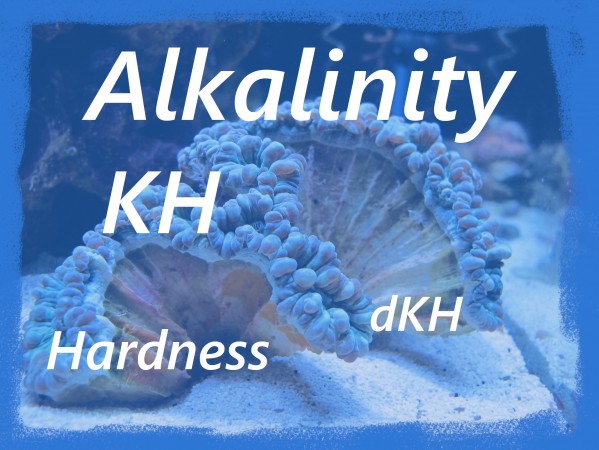
To keep it simple Alkalinity is the measure of carbonate in water. Alkalinity is essential to keeping stable aquarium parameters and is also used for the growth in corals in a reef tank. Corals use bicarbonates to build their skeleton structure, plus stable alkalinity encourages coral growth.
How is Alkalinity Measured?
Alkalinity is the total measurement of carbonate in the water and its measures through milligrams per liter (mg/L), Milliequivalents Per Litre (mEq/L), or as parts per million (ppm). In the aquarium industry, we measure carbonate hardness, also known as KH, which is measured by degrees and is referred to as dKH instead of mg/L or ppm. To convert dKH to mg/L, mEq/L, or ppm - 1 dKH is equal to 17.8 mg/L, 0.357 mEq/L or 17.887 ppm.
What’s the difference between Hardness and Alkalinity?
When measuring hardness, you measure half of the molecules in the water that represent calcium or magnesium, which is considered the hardness of the water. When you measure alkalinity, you measure the other half of the molecules, which are considered the carbonates. While they are two very different measurements in most cases, they have equal values when measured. That is why some test kits may say hardness, alkalinity or KH but they are providing the same results.
Why is Alkalinity Important?
Higher levels of alkalinity (2.79 dKH or 50 mg/L or ppm) tend to provide a more stable range of pH — the carbonates and bicarbonates’ can buffer the acids in the water. As your alkalinity is consumed, it causes your pH to be less stable or decrease suddenly, which can have adverse effects in an accruing by stressing species out, which can result in the death of the species.
In a reef tank, pH is important but your alkalinity level will also affect your calcium level. A large increase in alkalinity can cause calcium to drop. That is why when using two-part additives you are supposed to add equal amounts of alkalinity and calcium when dosing. NOTE: if you are having issues with your alkalinity and calcium levels test your magnesium levels, we will go over why in our aquarium magnesium spotlight.
How do Alkalinity and pH Interact?
Alkalinity helps stabilize your pH levels and keeps it from dropping too far. Your pH swings from low in the morning to high before the lights go out in your tank. Higher alkalinity will give you a higher pH daily average; alkalinity acts as a buffer to prevent your pH from dropping too much. When you increase your alkalinity, you also increase your daily average pH.
Why Does Alkalinity Drop Over Time?
Alkalinity is used to neutralize acids, and it drops over time due to waste build up in your tank and natural consumption of carbonate. If you have a saltwater tank, then your alkalinity is also affected by corals. Alkalinity is carbonate in the water, and corals use bicarbonate to grow their skeletal structure. As corals grow, they will absorb more bicarbonate. You may need to test alkalinity daily for a period of time to determine how much buffer needs to be added daily to replace what the corals have consumed. Keep in mind that as your corals grow they will consume more bicarbonates. Also, keep in mind if you remove a coral from your aquarium or a coral dies the amount of bicarbonate will also change and you could be overdosing your tank. This is why you have to regularly check alkalinity on a weekly bases to make sure you are at the correct level.
Ways to Replenish Alkalinity?
Alkalinity can be replenished easily through many different ways in a saltwater aquarium. Caution should be taken when making big swings in alkalinity, keep in mind that one dKH is considered a significant change. If you need to make a large change it is best to do it over a long period to across multiple days. A big swing in alkalinity can stress species out and show adverse effects or even possible death.
- Baking Soda - that’s right; in a pinch, you could use baking soda to adjust alkalinity in an aquarium. While possible and baking soda is considered food grade, it could have impurities.
- Kalkwasser - Kalkwasser is German and translates to limewater in English. It can buffer Alkalinity, Calcium, and pH. It has to be dosed precisely and slowly to prevent a significant swing in pH.
- Sodium Bicarbonate - baking soda is sodium bicarbonate, but you can get pure lab grade sodium bicarbonate, which is ideal. Lab grade sodium bicarbonate is less likely to introduce any impurities. It can be added directly to your aquarium in a high flow area, but in most cases, it is mixed with RO water and considered one part of a two-part solution, which makes it easier to dose. It also allows the use of dosing tools to automate the daily task.
- Water Changes - The process of removing water from your aquarium and replacing it with an equal amount of water. Water changes can replenish lost elements in your water. In a saltwater aquarium, most salts have elevated levels of alkalinity to help buffer your water parameters. Water changes are ideal if the water change is enough to buffer the drop in alkalinity since your last water change.
- Calcium Reactor - A calcium reactor dissolves carbonate media (or dead stony corals) in a chamber and slowly introduced back into the aquarium. How quickly it is reintroduced to the tank will vary depending on the alkalinity absorption rate. They can take a little bit of tinkering to get them set correctly, but once they are established, they are generally good for a while.
In a more established reef tank, the amount of alkalinity consumed in most cases is too high to replenish through just water changes. They require additional sources to introduce alkalinity.
How Often Should You Test Your Alkalinity Levels?
In a fish only aquarium, you can test your alkalinity about once a month. For both freshwater and saltwater aquarium once a month is fine. This is also the case for FOWLR (Fish Only with Live Rock) aquariums.
In a reef tank, alkalinity consumption varies and grows as your corals grow. It is suggested that you test your alkalinity on a weekly bases to avoid problems. To determine the amount of alkalinity you need to replenish, it is common to have to check alkalinity daily for a period of time.
What is Considered Ideal Alkalinity in Aquariums?
The ideal alkalinity will vary depending on the type of aquarium that you have as well as what type of species will be in the aquarium. For you to determine your ideal levels you should look into the need of each of the species that you have or plan to introduce to your aquarium to determine your level. The levels suggested below are industry guidelines to start with.
Ideal Alkalinity in a Freshwater Aquarium - This will vary by the type of fish you wish to keep. The fish origin will dictate the require Alkalinity level and can vary significantly. Many freshwater species are not compatible with one another due to their origins and required alkalinity levels. If you are looking to have a community tank, the ideal range should be 4-8 KH. An African Cichlid aquarium requires alkalinity levels between 10-18 KH. While a planted discus tank needs the alkalinity to be between 3-8 KH and ponds usually are between 4-8 KH. While you can use these ranges guidelines when you choose your species, make sure to look up the individual’s species needs.
Ideal Alkalinity for a Brackish Water Aquarium - Just like a freshwater tank, the species needs can vary depending on the origins of the species. With that said, the brackish water tank alkalinity range is higher between 10-18 KH.
Ideal Alkalinity in a FOWLR (Fish Only with Live Rock) Aquarium - An alkalinity range between 8-12 dKH is suitable for saltwater fish-only tanks.
Ideal Alkalinity for a Reef Aquarium - A reef aquarium is composed of both fish and corals there for it has to accommodate both types of species, so the desired alkalinity is between 8-12 dKH.
Ideal Alkalinity for a Coral only Aquarium - While not many people have coral only tanks due to having at least utilitarian fish in the tank to help keep things clean if you did have a coral only tank. Corals will be fine in an alkalinity range between 6-9 dKH.
How Can I Test Alkalinity in my Aquarium?
Many different test kits allow you to test your alkalinity in an aquarium in a few different ways. We go over the most common solutions to the most advanced solutions to keep track of your alkalinity levels. Some test gives you a range to give you an idea if you have a problem while others are more extract digital value of your alkalinity. The digital reading is great to see exactly how much alkalinity is being consumed on a daily bases. Here are the different alkalinity test kits available that you can buy.
API Test Strips |
|
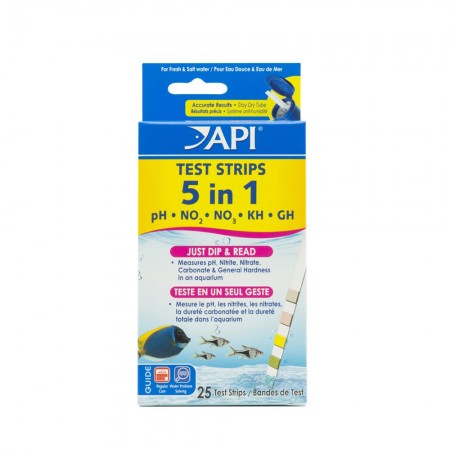
|
Not only is this the easiest option, but it is also one of the most affordable options to test alkalinity. Just open the container, pull out a dipstick, and dip it in your water. Wait a period of time and compare the color on the alkalinity value to the color chart. Cost about $10 |
|
Pros: Super Simple, inexpensive, easy to test, test 5 parameters at the same time Cons: You have to compare a color chart to determine the value, and it can be open to interpretation, will provide you with a range for the value. |
|
CHECK PRICE |
|
____________________________________________________________________
API KH Test Kit |
|
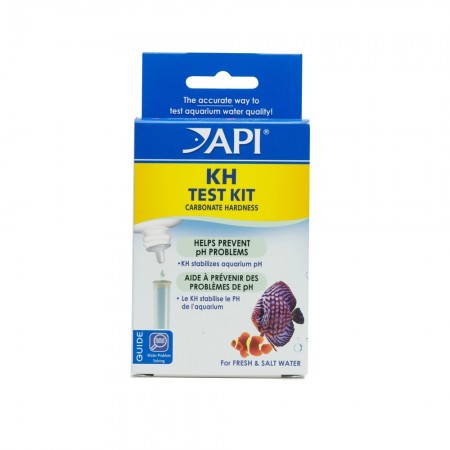
|
Super simple to run a test, I always have one of these test kist laying around. Just grab a sample of water and keep adding drops and stirring/shaking the water sample until the water changes color. Unlike the dipstick, you will see a sudden change in the color. Each drop is equal to one dKH. Cost about $21 |
|
Pros: Very inexpensive, you can quickly run a test, a quick idea of your alkalinity value Cons: The value is not the exact value; it’s still a range. |
|
CHECK PRICE |
|
____________________________________________________________________
Aquaforest Alkalinity Test Pro Test Kit |
|
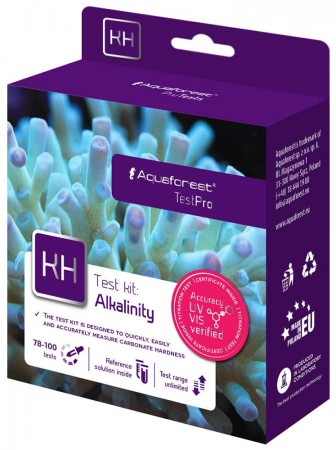
|
Aquaforest is well known in the industry and know for there labs grade products. This is the only test kit like this with two reagents, but they are simple to use. Just grab a sample of water, add three drops of the first reagent, fill the syringe with the second reagent until the plunger reaches the number one, and then keep adding drops to the water sample while stirring/shaking the water until the water changes color. Unlike the dipstick, you will see a sudden change in the color. Cost about $12 |
|
Pros: Trusted brand, great price, you can quickly run a test to get an idea of your alkalinity value Cons: The two reagents add an additional step to the process. The value is not the exact value; it’s still a range. |
|
CHECK PRICE |
|
____________________________________________________________________
Salifer KH/Alk Test Kit |
|
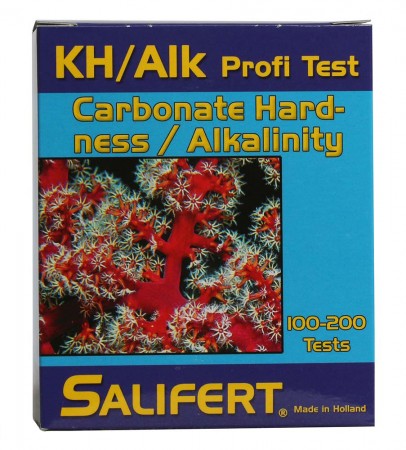
|
Super simple to run a test and the Salifer test kits are well known in the hobby. Just grab a sample of water, add three drops of the first reagent, fill the syringe with the second reagent until the plunger reaches the number one, and then keep adding drops to the water sample while stirring/shaking the water until the water changes color. Unlike the dipstick, you will see a sudden change in the color. Cost about $16 |
|
Pros: Trusted brand, you can quickly run a test to get an idea of your alkalinity value Cons: The two reagents add an additional step to the process. The value is not the exact value; it’s still a range. |
|
CHECK PRICE |
|
____________________________________________________________________
Giesemann Professional Alkalinity KH Test Kit |
|
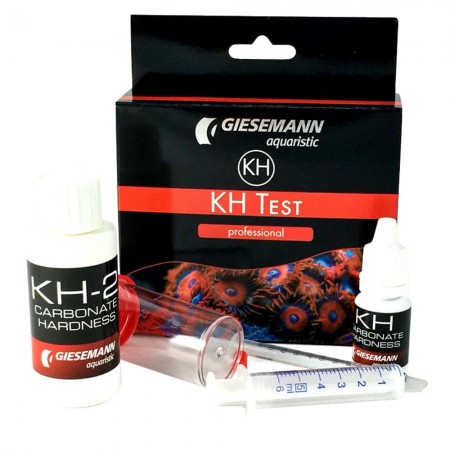
|
Super simple to run a test and the Salifer test kits are well known in the hobby. Just grab a sample of water, add three drops of the first reagent, fill the syringe with the second reagent until the plunger reaches the number one, and then keep adding drops to the water sample while stirring/shaking the water until the water changes color. Unlike the dipstick, you will see a sudden change in the color. Cost about $16 |
|
Pros: Trusted brand, you can quickly run a test to get an idea of your alkalinity value Cons: The two reagents add an additional step to the process. The value is not the exact value; it’s still a range. |
|
CHECK PRICE |
|
____________________________________________________________________
Red Sea Alkalinity Pro Test Kit |
|
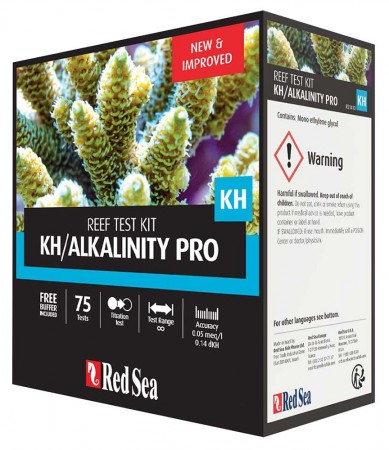
|
A well-designed test kit that makes it easy to perform most of the test using one hand. The test is easy to run and made by a well know trusted source in the hobby, Red Sea. Just grab a sample of water, fill the syringe with the second reagent until the plunger reaches the number one, and then keep adding drops to the water sample while stirring/shaking the water until the water changes color. Unlike the dipstick, you will see a sudden change in the color. Cost about $35 |
|
Pros: Trusted brand, you can quickly run a test to get an idea of your alkalinity value Cons: If you are not a fan of the design on the test kit, it is just an extra cost, the value is close to the exact value as long as you can read the syringe correctly. |
|
CHECK PRICE |
|
____________________________________________________________________
Hanna Instruments Checker Marine Alkalinity Colorimeter |
|
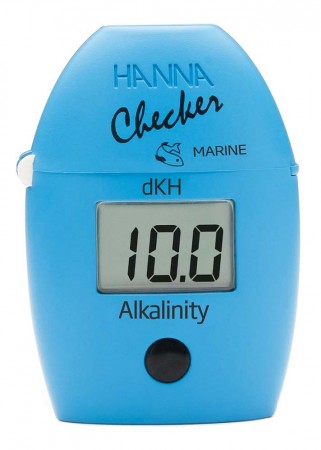
|
A great way to get an exact digital reading of your alkalinity brought to you by Hanna Instruments, who provides professional solutions as well. They come in dKH and a ppm version, depending on your desire. Just grab a sample of water, add the reagent to the water sample, place it in the Colorimeter, and press the button. It will then show you your alkalinity value. Once you're done, make sure to clean the container, but make sure that you do not scratch the glass as it can affect the way it reads. Cost about $50 |
|
Pros: Get an exact digital reading, Trusted brand Cons: You have to keep the test vile clean, scratches, and even fingerprints can cause a false reading. |
|
CHECK PRICE |
|
____________________________________________________________________
Trident Marine Aquarium Water Analyzer |
|
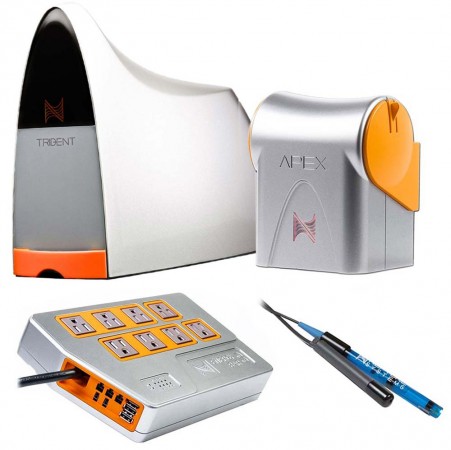
|
The Trident made by Neptune Systems who is known for the Apex Aquarium Controller came out with an automated tester that is able to test the core parameters for a reef aquarium which are Alkalinity, Calcium, and Magnesium. It does not work independently, it connects to your Apex Controller. Not only will the Trident measure the core components but it more accessories it can take action on the results and automatedly dose to trigger a water change. The Trident alone cost about $599.99 |
|
Pros: Get an exact digital reading, automatically logs results so you can see a trend, well-known brand, automate an action based off of a result Cons: Costly setup that ads up quickly costing over $1,000 for the Trident and the Apex controller, reagents will cost about $17 a month |
|
CHECK PRICE |
|
____________________________________________________________________
Regardless of how you test your alkalinity levels, it’s essential to keep a log of your water parameters. Tank Facts allows you to create a free account and keep a digital water log for all of your tanks. Just click on My Tank(s), add one or more tanks to start logging your water parameters today.




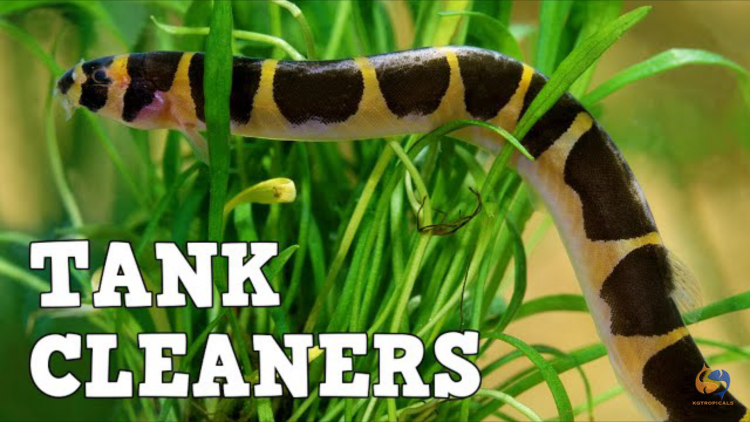

About author
I have been in the hobby for a while, my main focus is automation. I am interested in doing aquaponics in 2018.